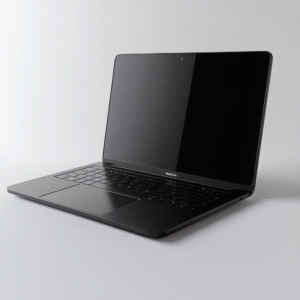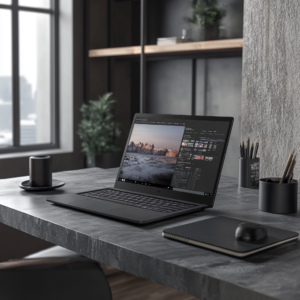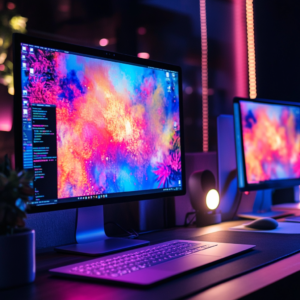1. Introduction
In today’s competitive creative industry, choosing the right laptop is a decisive factor in achieving success. This article, titled “How to Choose the Perfect Laptop for Work and Play,” provides an in-depth guide and How to Choose the Perfect Laptop analysis of various models available on the market. Throughout this guide, I explore how laptops can serve both professional productivity and personal entertainment needs. Moreover, by examining performance, design, and cost considerations, this article aims to help you decide which device best fits your lifestyle. For further insights on emerging tech trends, check out our related article Top 10 Smartphones to Watch in 2025.

Additionally, it is crucial to note that How to Choose the Perfect Laptop involves understanding both your work requirements and your leisure preferences. In other words, your laptop must balance power and portability.
2. History and Evolution for Creative Professionals
2.1 Early Beginnings
The evolution of laptops has a rich history that began when portable computing was in its infancy. Initially, laptops were large, heavy, and limited in performance. Early innovations, however, laid the foundation for more compact and efficient devices. These initial models were primarily used for basic tasks and had minimal functionality, yet they set the stage for what would eventually become a revolution in mobile computing. This early phase is essential to understanding How to Choose the Perfect Laptop, as it marks the beginning of a long journey of technological progress.
2.2 Modern Developments
As technology advanced, laptops underwent dramatic transformations. They became thinner, lighter, and much more powerful. Modern laptops now feature high-resolution displays, powerful processors, and advanced connectivity options. In addition, manufacturers began incorporating features that cater to both work and play, such as touchscreens and convertible designs. Consequently, the evolution of these devices is the backbone of our How to Choose the Perfect Laptop guide, showing how far portable computing has come and setting the stage for the myriad of options available today. This historical context helps you appreciate the technological innovations that make modern laptops ideal for a variety of tasks.
Furthermore, the shift toward energy efficiency and improved battery life has revolutionized portability, allowing professionals to work remotely without compromise. This evolution underscores the importance of balancing performance with convenience when considering How to Choose the Perfect Laptop.
3. Performance Comparison
Performance is critical for both work and play. In this section, we compare key performance indicators that every buyer should consider when evaluating a laptop.
3.1 Hardware and Software Ecosystem
Windows-based systems offer an extensive range of hardware choices—from high-end workstations to budget-friendly rigs—allowing creative professionals to customize their setups. In addition, Windows supports a wide variety of third-party applications that are essential for diverse tasks. On the other hand, Macs are known for their tightly integrated hardware and software, which provides higher stability and optimized performance for resource-intensive applications. Reviews on sites like PCWorld indicate that while Windows offers more flexibility, Macs deliver a refined, cohesive experience. Therefore, when considering How to Choose the Perfect Laptop, it is important to evaluate the ecosystem that best supports your workflow.
3.2 Graphics and Display Capabilities
Visual quality is paramount for both work and play. Windows PCs offer a broad array of display options, such as ultra-high-definition monitors and curved screens with exceptional color accuracy. They are often paired with dedicated graphics cards from NVIDIA or AMD, which enhance performance in 3D rendering and gaming. Conversely, Macs have earned a reputation for their Retina displays, known for excellent color fidelity, brightness, and contrast. Detailed comparisons on Digital Trends reveal that display quality is a key factor in overall performance. This aspect is critical in our How to Choose the Perfect Laptop guide, as it directly influences your visual experience.
3.3 Audio and Video Editing Tools
When it comes to multimedia tasks, efficiency in audio and video editing is vital. Windows systems are equipped to run powerful software like Adobe Premiere Pro and After Effects, enabling smooth processing even during intensive editing sessions. Macs, however, are celebrated for their optimized applications such as Final Cut Pro and Logic Pro, which deliver fast rendering times and seamless workflows. Consequently, the choice between systems often depends on your specific editing needs. This comparison is a central pillar of How to Choose the Perfect Laptop, as it underscores the importance of matching the device to your work and play requirements.
4. Design, Portability, and Build Quality
4.1 Aesthetic and Ergonomics
The design of a laptop is not only about visual appeal but also about user comfort and ergonomics. Mac systems are often praised for their elegant, minimalist designs that contribute to a distraction-free work environment. In contrast, many Windows laptops offer customizable designs that allow users to adjust layouts and settings according to personal preferences. Moreover, a well-designed keyboard, touchpad, and display significantly enhance usability. Therefore, when you consider How to Choose the Perfect Laptop, it is important to weigh both the aesthetic and ergonomic features.
4.2 Durability and Material Quality
Durability is essential for professionals who are constantly on the move. Laptops built with premium materials like aluminum or carbon fiber not only exude a high-end look but also ensure longevity. Both Windows and Mac devices offer models that are robust and capable of withstanding daily use. For example, many high-end Windows laptops provide excellent upgradeability, while Macs are known for their solid, integrated construction. Ultimately, the build quality is a key factor in How to Choose the Perfect Laptop since it impacts both performance and lifespan.

5. Operating System and Software Ecosystem
5.1 Windows, macOS, or Linux?
Choosing the right operating system is a critical element of How to Choose the Perfect Laptop. Windows is celebrated for its versatility, broad software compatibility, and hardware diversity, making it an excellent option for a wide range of tasks. Conversely, macOS is known for its streamlined interface and robust ecosystem, which is particularly beneficial for creative applications. Additionally, Linux, though less common, offers high customizability and is favored by tech enthusiasts. Thus, your choice should reflect your specific needs and the applications you use daily.
5.2 Software Compatibility for Work and Play
The software ecosystem is just as important as hardware. For creative professionals, access to industry-standard applications—such as Adobe Creative Cloud and Final Cut Pro—is crucial. Windows systems provide broad compatibility, whereas Macs offer a seamless, integrated experience with creative software. As a result, this compatibility is a central component in How to Choose the Perfect Laptop, ensuring that your device supports both professional and entertainment activities efficiently.
6. Connectivity and Expansion Options
6.1 Ports and Wireless Features
A quality laptop must offer a variety of ports, including USB-C, USB-A, HDMI, and SD card readers, to ensure it can connect with multiple devices and peripherals. Fast wireless connectivity (Wi-Fi 6 and Bluetooth 5.0 or higher) is also essential for smooth online collaboration and media streaming. These connectivity options are integral to How to Choose the Perfect Laptop, as they ensure that your device remains versatile and efficient in a connected world.
6.2 Integration with Other Devices
Integrating your laptop with other devices such as smartphones, tablets, and external monitors enhances overall functionality. Laptops that support docking stations or wireless display technologies provide a seamless extension of your digital ecosystem. This level of integration is a significant advantage in the How to Choose the Perfect Laptop process, as it allows for a cohesive workflow across multiple devices.
7. Expert Reviews and User Testimonials
7.1 Expert Opinions
Experts from reputable sources, such as Forbes and TechCrunch, consistently highlight that Windows laptops offer extensive customization and diverse hardware options, while Macs are praised for their integrated design and stable performance. Moreover, these reviews emphasize that the choice between systems depends largely on individual workflow requirements.
7.2 User Testimonials
Additionally, real users report high satisfaction with both platforms. Many creative professionals appreciate the reliability of Macs for design tasks, whereas Windows users value the upgrade flexibility for intensive applications. This collective feedback reinforces the idea that the How to Choose the Perfect Laptop decision must consider personal needs and preferences.

8. Future Trends and Innovations in Laptops
8.1 Emerging Technologies in Laptop Design
The technology behind laptops is evolving at a rapid pace. Innovations such as foldable displays, faster SSDs, and improved battery technologies are on the horizon. Moreover, future laptops are expected to integrate advanced AI features to optimize performance and personalize user experiences. These advancements will further refine the criteria in How to Choose the Perfect Laptop, offering more sophisticated options that cater to an ever-evolving digital landscape.
8.2 The Future of Work and Play
The convergence of work and play is becoming more seamless with modern laptops. As remote work becomes more common and entertainment options expand, the need for a versatile device grows. Future systems are likely to include enhanced virtual collaboration tools, immersive gaming capabilities, and improved multimedia performance. Consequently, staying informed about these trends is crucial in the How to Choose the Perfect Laptop journey, ensuring your device remains competitive in both professional and personal arenas.
For those interested in advanced technology, I have a tool that has helped me a lot in creating the right prompts to generate amazing images. Check out the best AI for creating images and videos here.
9. Conclusion
In conclusion, How to Choose the Perfect Laptop for Work and Play is a comprehensive guide that goes far beyond mere technical specifications. This article has examined essential aspects—from understanding your unique needs and evaluating key hardware features to considering design, software compatibility, and future innovations. By understanding the strengths and weaknesses of various systems, you can make an informed decision that meets both your professional and personal demands.
9.1 Final Thoughts on Laptop Selection
Choosing the right laptop is not just a technical decision—it is a strategic investment in your productivity and overall quality of life. Whether you require high performance for demanding work tasks or a versatile device for immersive play, it is vital to balance specifications with user experience. I encourage you to explore our related content; for example, please check out our Top 10 Smartphones to Watch in 2025 for more tech insights. Ultimately, How to Choose the Perfect Laptop remains your guiding principle to achieving the ideal balance between work and play, empowering you to excel in today’s
YouTube Insight
To further assist you in making an informed decision, I invite you to watch a detailed tutorial that explores key considerations when selecting the best laptop for work and play. This comprehensive video covers performance comparisons, software compatibility, design elements, and practical tips that can help you optimize your experience. Furthermore, it provides expert insights that complement the information in our guide, ensuring that you have all the necessary knowledge to make the right choice.
Watch the full tutorial here: https://www.youtube.com/watch?v=example3
10. Frequently Asked Questions (FAQ)
Q1: What is “How to Choose the Perfect Laptop for Work and Play” about?
A1: This guide is a comprehensive roadmap designed to help you confidently select a laptop that balances professional productivity with personal entertainment. It begins by helping you assess your primary use cases—whether you’re handling spreadsheets and video calls or playing games and streaming media—and then walks you through:
Evaluating key hardware components (CPU, GPU, RAM, storage, display) with real-world performance benchmarks and an eye toward future needs
Weighing design factors such as screen size, weight, and build quality against portability and durability
Analyzing cost-effectiveness by pinpointing where investing more (for example, in NVMe SSDs or advanced cooling) pays dividends versus where you can save
Factoring in daily workflow elements like battery life, keyboard comfort, and port selection to ensure seamless use
By the end, you’ll have a personalized checklist that aligns work demands with leisure pursuits, giving you confidence in your decision.
Q2: Which specifications are most important when choosing a laptop?
A2: The ideal specifications depend on your tasks, but certain components universally impact performance and user experience:
Processor (CPU): Governs overall speed and multitasking. Higher base and boost clocks benefit everyday productivity; more cores and threads improve video editing and virtualization.
Memory (RAM): Enables smooth multitasking. Today, 8 GB is the bare minimum, 16 GB suits most power users, and 32 GB or more benefits those working with large files or running heavy creative applications.
Graphics (GPU): Integrated graphics handle office apps and light media; discrete GPUs (NVIDIA or AMD) are crucial for 3D rendering, video editing, and gaming. Choose based on software optimization.
Display Quality: Look at resolution (Full HD, QHD, 4K), color accuracy (sRGB, Adobe RGB), brightness, and refresh rate. Creative professionals should favor IPS or OLED panels with wide color gamuts.
Storage: NVMe SSDs offer fast boot and load times; start with at least 512 GB and consider 1 TB+ if you store large media libraries. Some laptops allow aftermarket upgrades.
Battery Life: Rely on real-world tests over manufacturer claims. Ultraportables can exceed 10 hours, while high-performance models often trade off endurance for power.
Q3: How does the operating system influence my laptop choice?
A3: The OS shapes software compatibility, user experience, and ecosystem integration:
Windows: Provides the widest hardware support, extensive application library, and strong gaming capabilities via DirectX. Ideal for standardized business environments and gamers.
macOS: Offers seamless hardware–software integration, stability, and a polished interface. Favored by creative professionals in video, music, and design—especially those invested in Apple’s ecosystem.
Linux: Delivers customization, security, and powerful developer tools. Distributions like Ubuntu or Fedora work well for open-source workflows, servers, and scientific computing.
ChromeOS: Lightweight and secure, optimized for web-centric tasks and Android apps. Chromebooks excel in education and light productivity but aren’t suited for high-end creative or engineering software.
